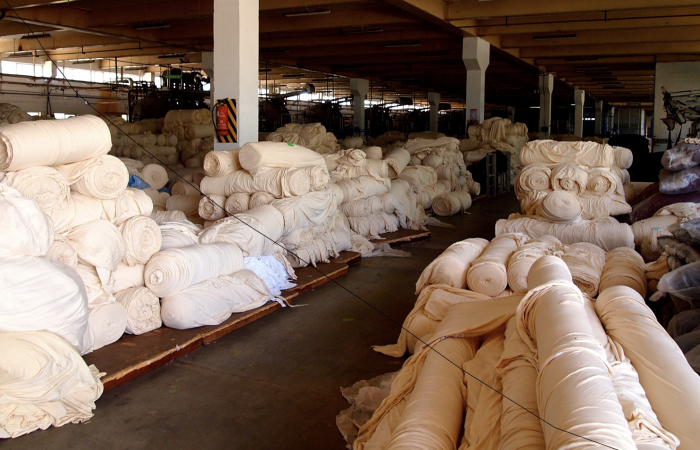The Dirty Truth Behind our Clothes

Rebekah Smith, MSc: Sustainable Development in Practice. Through her BA in Fashion Buying & Merchandising, Rebekah specialises in the fashion supply chain with a personal interest in the cotton industry, specifically cotton production and how to render it more sustainable.
During my career development in the fashion industry and field research in India I have become aware of the huge impact the cotton industry has on soils and the environment, an issue that it appears many people are completely unaware of. This must be changed. As cotton is plant-derived, I have found there is a common belief that it must be an environmentally-friendly fabric to produce when compared to synthetic fibres. This could not be further from the truth.
With the rise of cheap clothing and the pressures of profit margins, most of the fashion industry has been off-shored to countries where pay is at a minimum and lack of regulation allows for serious pollution of the environment. The cheap price we pay for our clothing masks the environmental cost to the planet that occurs throughout the supply chain - from growing and harvesting cotton to create fabric, to the chemical dyeing and finishing of fabrics, right up to the end-of-life disposal. One of the most alarming aspects of this for me is how far removed we are from the true cost of our clothing, socially and to the environment. I am keen to raise awareness about the situation and inspire change.
Cotton - the world’s dirtiest crop
Cotton accounts for roughly 40% of global textile production (1), and with around 123.7 million 480-pound bales grown globally per year (2), the enormous scale of impact that it is having on the planet and the soil is somewhat overwhelming. Some of the key issues relating to cotton and soil management are persistent chemical use (3), soil fertility depletion through denitrification and nitrogen leaching, soil contamination, and soil erosion (4). This is because cotton is generally grown very intensively and, as a crop, it is sensitive to weed competition and very susceptible to pest attacks that damage yields, consequently leading to the extensive use of chemical herbicides and insecticides.
Cotton uses 6% of the world’s pesticides and 16% of the world’s insecticides. This is more than any other single major crop, classifying it as the world’s dirtiest crop (3).
This is a shocking fact. I truly believe that the common production practices should be questioned in terms of the long-term effect on the health of the soil and the people working with it. Chemicals that are considered highly hazardous to people and insects such as bees are still widely used in cotton production (5).
Seeds of destruction
The intensification of cotton production has led to the domination of Genetically Modified (GM) strains throughout the seed market. The GM seed is designed so that the seed itself has become an insecticide (through use of the soil-dwelling bacteria Bacillus Thuringiensis) therefore, in theory, lessening the need for chemical spray-on insecticides. GM seed now monopolises the major cotton growing countries - for example, Australia, India, China and Brazil, where over 90% of cotton seed is GM (5,6,7,8). This has led to a decrease in seed variety and, in some instances, to farmers uptaking a technology which they do not fully understand (9). And whilst GM seed theoretically works, in practice the long-term effectiveness is disputed with pests developing genetic resistance, damaging yields and consequently leading to a ‘treadmill’ effect whereby additional insecticides are needed to combat the problem (10). With such extensive use and an estimated only 0.1% of pesticides reaching the targeted pests (11), these destructive chemicals have been found to greatly impair human health (12) and pollute groundwater, rivers, lakes and the soil (5). This is causing stress on the health and fertility of the environment. There is also uncertainty around the direct effect that the plants’ roots have with non-targeted soil organisms and the symbiotic relationship between key fungi and plant nutrient absorption (13).
Additionally, the heavy expenses of the seed, in combination with damaged yields through pest resistance, is also known to be causing a vicious cycle of farmer debt (9). Indeed, there is speculation that the economic burden of GM cotton and agrochemicals has driven tens of thousands of farmers in India to suicide (9).
Conclusively, the business-as-usual method of cotton production needs to be challenged and, through much research, I have come to the verdict that the risks of using GM seed and persistent agrochemicals are too high to warrant these currently commonly-used farming practices.

Organic cotton, a seed of hope?
With the diverse span of impact and universal participation of the fashion industry, the sector holds the potential to play a critical role in fighting climate change whilst protecting the soil and minimising land and water pollution. Fortunately there is still hope for change, as positive advances are taking place throughout the cotton industry. Retailer and consumer awareness is increasing and, with this, the pressure for companies to change the way they procure, creating demand for better methods of production. There are ‘more sustainable’ alternatives such as the Better Cotton Initiative and Cotton Made In Africa but, in my opinion, organic cotton is the best option for the fashion industry to work towards for a sustainable supply chain that benefits all.
The credentials of organic cotton
The organic production of cotton is known as the ‘gold standard’ farming technique to grow the crop. This strict practice prohibits the use of GM seed and it is possible for persistent pesticides and fertilisers to be completely eliminated. It requires mindful soil husbandry, crop rotation and natural pest management solutions to control pests and build soil nutrients. Because of this, the risk of polluting waterways and the land is reduced, and biodiversity can be increased (14). Topsoil can be increased (11) and soils become stronger, which in turn can then sequester more carbon from the atmosphere (15). The farmer also benefits as crop rotation allows for an increase in food security and a reduction in financial reliance on one single crop (14).
In addition to these benefits, a peer-reviewed life-cycle analysis (16) of organic cotton in comparison to conventional cotton found that organic cotton has:
-
91% reduced blue water consumption (water taken from groundwater or surface water bodies via irrigation): this is critical in drought susceptible areas
-
70% less acidification potential
-
26% reduced eutrophication potential (soil erosion)
-
46% reduced global warming potential. One of the most pressing concerns of our time: the amount of greenhouse gasses emitted from the production of cotton which, in this case, can be attributed to less chemical pesticide/fertiliser use, as well as the differing farming techniques used in conventional and organic systems.
Organic cotton and the fashion industry
There is no doubt to me that organically farming cotton is far superior to conventionally farming cotton. However, whilst the potential benefits speak for themselves, organic cotton currently represents less than 1% of the whole cotton industry (17). And although this is considered small, the market has huge potential for growth, expanding the supply and accessibility to retailers. With this, I am interested in the barriers to greater uptake of organic cotton. In my research I found the key barriers to be: price; consumer awareness; retailer awareness; and availability of organic cotton.
To increase uptake, educating fashion retailers and consumers on why organic cotton is needed is paramount. A growth in interest is crucial as it presents farmers with a business case for them to convert to, and continue with, organic. Crucially, the higher price of organic cotton and the reasoning behind this must be understood throughout the industry and by the consumer, so that value and respect is given to the increased workload, certification costs and initial drop in yields during the conversion period. A promotion of fair prices throughout the supply chain should then decrease the risk of cotton integrity being jeopardised.
Conclusion
What is clear is that cotton has the potential to be farmed in a far less detrimental way. With this, the true cost of cotton must be understood. I am optimistic that this can happen. Already some major retailers are developing organic product lines.
So next time you buy a cotton t-shirt or a new pair of socks, think - how has this cotton been grown? Has it positively or negatively affected the soil and the environment? It is my belief that it is absolutely crucial, if this industry is to develop ethically, to demonstrate to fashion retailers that the consumer cares: by voting with our purchases and only buying cotton that is sustainably grown.
Look out for organic cotton, and favour companies that prioritise the environmental credentials of a product. The fashion industry can change, if only we each change our own priorities in clothing purchases and examine what our choices represent.
I co-wrote the recent Soil Association Organic Textile Market Report, available for download here.
REFERENCES:
-
CottonConnect (2018). Why sustainable cotton?
-
Statista (2019). Global cotton production volume from 1990 to 2018.
-
Pesticide Action Network (2017a). Pesticide Concerns in Cotton.
-
Food & Agriculture Organisation of the United Nations (2015). Measuring Sustainability in Cotton Farming Systems.
-
Pesticide Action Network (2017b). Is Cotton Overcoming Its Chemical Addiction?
-
ISAAA (2017). Biotech Country Facts & Trends India
-
ISAAA (2017). Biotech Country Facts & Trends China
-
ISAAA (2017). Biotech Country Facts & Trends Brazil
-
Thomas, G. & De Tavernier, J (2017). Farmer-suicide in India: debating the role of biotechnology. Life Sci Soc Policy. 13 (8)
-
Myers, D. & Stolton, S. (1999). Organic Cotton: From Field to Final Product. London: Intermediate Technology Publications.
-
Rieple, A. & Singh, R. (2010). A value chain analysis of the organic cotton industry: The case of UK retailers and Indian suppliers. Ecological Economics. 69 (11), pp. 2292-2302
-
Reddy, D.N. and Kumar, D. (2017). Pesticide Poisonings in Yavatmal District in Maharashtra: Untold Realities [online]. India: PAN India.
-
Chen, X., Zhang, R. & Wang, F (2017). Transgenic Bt cotton inhibited arbuscular mycorrhizal fungus differentiation and colonization. Plant Soil Environ., 63: 62–69
-
Textile Exchange (2016). Achieving SDGs Through Organic Cotton.
-
Soil Association (2009). Soil Carbon and Organic Farming.
-
Textile Exchange (2017). The Life Cycle Assessment Of Organic Cotton Fiber Summary Of Findings- A Global Average.
-
FiBL & IFOAM (2018). The World Of Organic Agriculture - Statistics and Emerging Trends 2018.